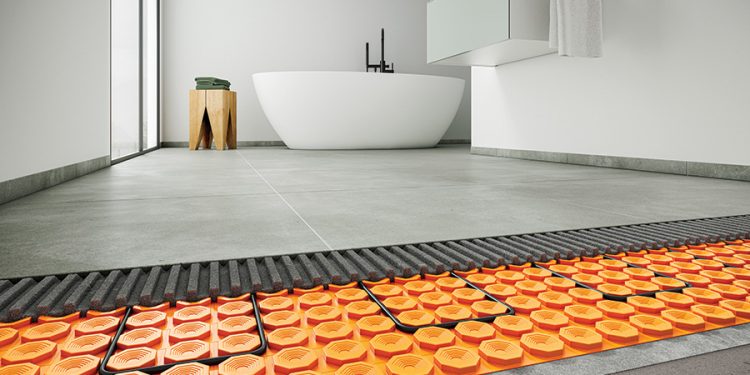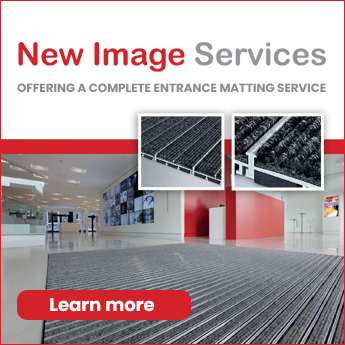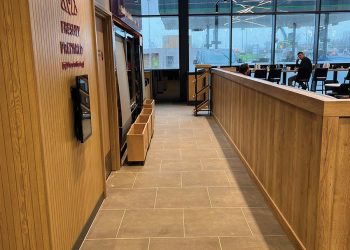GIVEN ever-increasing focus on more energy efficient and comfortable heating solutions, alongside continuing technological advancements in this area, it is not surprising to see reports of global growth in underfloor heating technologies. Considered in tandem with the positive impact that use of these systems has on the design of rooms, these features make for a solution that is all the more appealing in the eyes of the conscientious specifier.
Tile and stone are great partners to underfloor heating, due to their high thermal conductivity and good heat retention credentials—these properties make for a quick warm-up and more efficient use of energy. Schlüter-Systems offers both electric and hydronic systems that make the most of modern technology, to the benefit of parties across the construction chain. These systems can also be used with other floor coverings approved for use with underfloor heating, as well as with tile and stone.
Both electric and hydronic systems meet the demand for modern technologies whilst enhancing everyday living, and there are also a number of reasons to use hydronic systems that meet the demands for energy-efficiency.
Why use electric?
Electric systems are intended to be used as a secondary heat source, this means they offer added comfort to floor surfaces like tile by keeping them warm, but they are not designed to heat the air temperature in the room. They are operated using wires which are connected to the mains power supply that generates heat to warm the floor covering. Electric systems offer an abundance of advantages, including:
Integration with smart technology
A shift towards digital in recent years has led to increasing numbers of commercial and residential properties adopting smart technology, creating a more seamless environment for the inhabitants of the building. Schlüter’s DITRA-HEAT-E range is available with a range of thermostats, so specifiers can choose the one that closely matches the needs of the building or its occupants. The latest smart stat DITRA-HEAT-E-R6 features a discreet 2.5” touchscreen display, is WiFi enabled and is compatible with voice control technology.
New installation technology
Peel and stick technology has made installing electric underfloor heating systems even easier. Schlüter’s DITRA-HEAT Peel & Stick is a more convenient way of installing electric underfloor heating. Peel & Stick has a pressure sensitive adhesive laminated to the underside whilst still featuring the same key benefits as the tried-and-tested DITRA-HEAT. By eliminating the need for tile adhesive underneath the mat, installation times are sped up and less material is required, a huge advantage for the eco-conscious specifier.
Zonal heating for precise usage
Where electric systems really come into their own is in the provision of concentrated zonal warmth, adding comfort where it is needed. This feature allows for even more precise usage and are a great choice for infusing additional luxury into particular areas of a building and enhancing the routines of its occupants.
Examples of this include:
Use within bathrooms and wetrooms, to make early morning preparations more pleasant and dry out residual moisture
Use around popular communal standing areas in a home, e.g. surrounding kitchen islands
Use in the creation of heated features, e.g. benches, shelves and walls

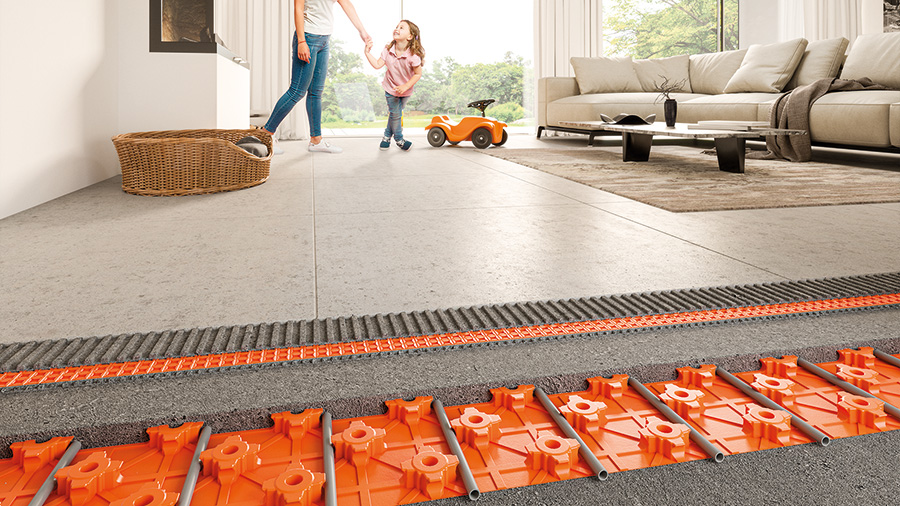
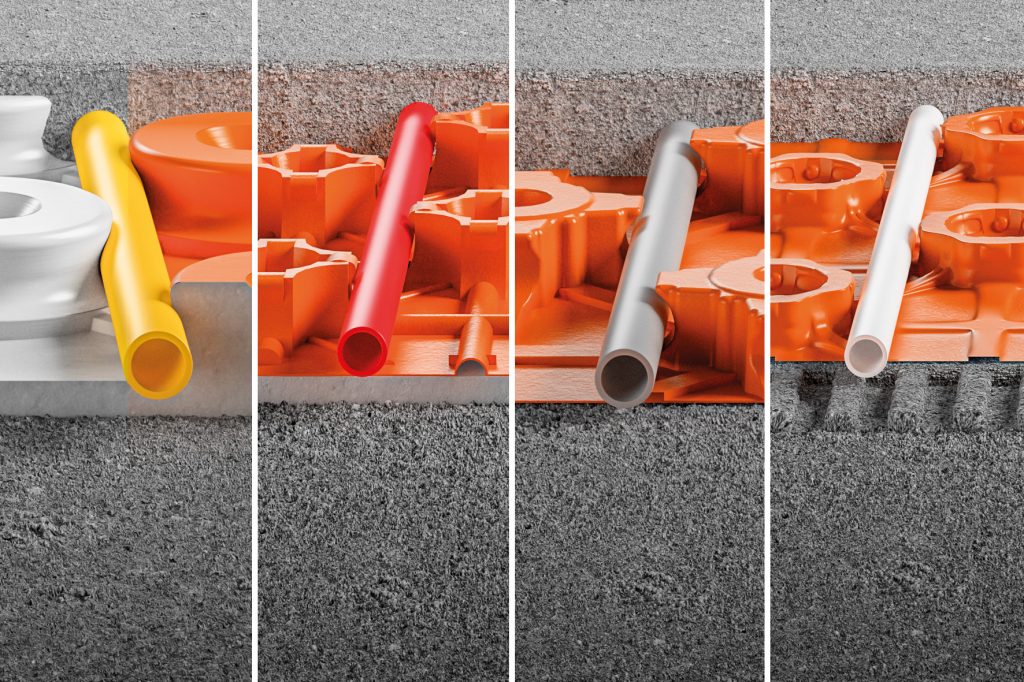
Warmth on demand
In that vein, electric systems are also extremely responsive, taking a short amount of time to warm up due to their proximity to the surface. The exact amount of time taken will vary slightly, dependent on watts per m2, tile thickness and insulation, or the incorporation of a thermal break. Essentially, electric systems provide warm floor coverings on demand.
Thermal breaking and impact sound reduction
The DITRA-HEAT-E system can be specified with the advanced Schlüter®-DITRA-HEAT-DUO matting, which boasts the additional features of an integrated thermal break and impact sound reduction of up to 13dB.
These two additional features are achieved thanks to a unique 2mm fleece layer on the underside of the uncoupling membrane, which allows 80% of the heat to rise to the surface during the heat-up phase for up to 70% faster response time, as well as reducing impact sound by a perceived 50%.
A thermal break is an element within an assembly which reduces the flow of thermal energy between conductive materials. The thermal break in DITRA-HEAT-DUO ensures that the heat doesn’t get lost but is instead transferred directly to the floor covering above.
This combination of fleece and matting allows an input of 136 W/m2, to push up to 110 W/m2 to the surface on initial start-up, reacting faster than 200 W/m2 systems and making Schlüter®-DITRA-HEAT-E-DUO cost less to run compared to other systems, which lose 50% of their heat into the slab below on initial start-up phase.
Why use hydronic?
An alternative to installing an electric system is to use a wet (hydronic) system to provide an in-screed primary heating solution. Wet systems are designed to operate as a primary heat source, meaning the installation of these systems can directly replace alternative heat sources such as traditional radiators. They are operated using a network of pipes through which hot water is circulated. These pipes are typically connected to boiler systems, but they can also be connected to other heat sources such as a heat pump. To connect the pipes to a heat source requires a manifold and mixing valves dependant on the heat source.
Hydronic systems equally offer many advantages, which are focused on the eco-credentials and technological features.
Reduced screed requirements
The considerably lower installation height of the BEKOTEC-THERM underfloor heating system, coupled with the unique design of the Schlüter®-BEKOTEC modular screed panel, means less screed is needed—making it easier, quicker and cheaper to install and run. Less screed also means a reduced environmental impact both in terms of producing the amount of screed needed for the system (only 8mm over the system studs compared to the 65-75mm needed over traditional systems) and also in terms of heating this reduced mass of screed.
Compatible with environmentally friendly energy sources
Less screed means the heating pipes are located closer to the surface. As a result, the underfloor heating system can run at considerably lower temperatures and still achieve the same heating results. A low supply temperature of approximately 30°C to 55°C means Schlüter®-BEKOTEC-THERM is also extremely effective both with conventional heat generation devices and regenerative energy sources. The ability to run at lower temperatures makes the BEKOTEC-THERM underfloor heating system suitable for use with heat pumps, as well as other environmentally friendly energy sources that work more efficiently at lower temperatures, making it a green choice with economical and energy saving properties.
Heating and cooling when it’s needed
Due to the large screed mass above the heating pipes of traditional wet underfloor heating systems, the time it takes to heat a room or to cool the floor covering is much longer. The impact of this will be noticeably evident when it comes to changes in weather conditions which require a change in room temperature.
The thinner screed mass above the heating pipes of Schlüter’s wet system means the heating is closer to the surface so when there are changes in weather conditions that require a change in the room temperature, the system can react much quicker.
The modular screed panels of the system are designed to hold the heating pipes in place at regular and exacting intervals, resulting in a more even heating experience than you would get with either radiators or traditional underfloor heating systems.
Innovative control
The efficiency of a heating or cooling system depends largely on its hydronic balancing. It provides every heating circuit with exactly the right supply volume and makes the heating system especially responsive and energy efficient.
The new actuator, Schlüter-BEKOTEC-THERM-EAHB ensures adaptive hydronic balancing with its self-learning ability. An integrated artificial intelligence component optimises the spread between the measured temperatures and continuously adjusts it to variable situations based on stroke motion.
A range of other control modules and room sensors for the BEKOTEC-THERM system add flexibility and convenience to the regulation of room temperature. The core of the system can be connected to a timer module for energy-saving temperature reduction and the connection modules for wired or wireless room sensors can be freely combined with the base module, which enables the flexible expansion of existing systems at any time. Modern wireless and wired room sensors allow for individual room temperature control to suit requirements.
Approved installations for peace of mind
BEKOTEC-THERM has a covering and assembly warranty, training can be provided at the Schlüter-Systems offices or on-site. We also follow each project through to completion, making sure each stage of the assembly is carried out according to our installation instructions. Design drawings and installation guides are provided with every supplied primary heating system.
Installing coverings aside from tile and stone
The Schlüter-DITRA-HEAT-E system can also be used with other coverings aside from tile and stone, such as timber, laminate, vinyl, LVT, carpet etc., as long as they are explicitly approved for use over electrical underfloor heating by their manufacturers.
This applies for both systems laid as a floating installation as well as for those firmly adhered. A few key requirements must be met in terms of the other characteristics of the installation, which Schlüter-Systems will be happy to advise upon.
General rules for all underfloor heating systems
Though there are many options in terms of the floor coverings that can be used over electric and hydronic underfloor heating systems, there are a couple of key restrictions to bear in mind. The first is that the floor temperature when using timber coverings cannot exceed 27°C (vs. 29°C with tile and stone). The second is that the tog rating for any carpet and underlay combination installed over underfloor heating must not exceed 2.5 tog. If in doubt as to whether your proposed floor covering is suitable for use over underfloor heating, always consult the manufacturer for guidance.
Learn more about specifying underfloor heating
The CPD seminar ‘Specifying Integrated Underfloor Heating Systems’ covers the key considerations in the specification of a modular underfloor heating system that helps to protect tile and natural stone floor coverings from cracking, splitting, tenting and debonding, and explores the theory behind modular screed systems. Enhance and reaffirm your knowledge with this 45 – 60 minute presentation, held at your offices or online.
For support across all elements of your specification journey – from learning about the fundamentals of tiling systems, through to project-specific advice and detailing – call 01530 813396 or email specification@schluter.co.uk.
Schlüter-Systems Ltd’s website is a helpful companion for architects and specifiers tasked with achieving first-class installations of tile and stone; head to www.schluter.co.uk.
SCHLÜTER-SYSTEMS
01530 813396
specification@schluter.co.uk
www.schluter.co.uk



